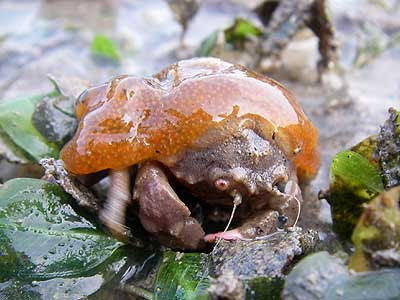While KS and company were out on Chek Jawa monitoring its recovery, and at the same time, sighting huge orange cake sea star and pink knobbly sea stars, a trio of Semakau guides (LK, ST & I) on out on an unexplored part of Ubin, or at least, unexplored by anyone we know.
So what made me decide to make this trip? Last Saturday, I took a quick at the area when the tide wasn't that low, and saw a lovely stretch of spoon seagrass with many sponges. Seagrasses and sponges are food for many marine animals, and when you can find the food, you can usually find the food-eater too.
And indeed, the area didn't disappoint me.
Colourful sponges were every where! In the little area above, there were at least 6 different types of sponges. Can you find them? Sponges are simple animals with lots of tiny holes and a few bigger holes on it. They feed by sucking water through the little holes and filter any edible particles from the water. The filtered water will then be pushed out of the bigger holes.
And there were many bigger-than-your-face carpet anemones too! Can you see the opening it the middle? That's its mouth. the anemone has sticky tentacles which it uses to trap animals that got too close to it. The tentacles eject little toxic stings into the unlucky prey, and then slowly move it to the mouth in the middle.
Swimming anemones appeared to be in season, as we saw many of them among the spoon seagrass. As the name implies. this anemone can swim by pulsating itself!
And on the rocks, there very many cute little snails, including the little cowrie above.
Unfortunately, the only sea star we found was this sand star with only 2 complete arms. It was still alive though, and hopefully it can regenerate its arms before it ends up in some other animal's stomach.
There were plenty of brittle stars though. They are so named because their arms break easily, and this helps to distract predators which caught hold of the broken arm.
We also saw several of the usual sea cucumbers found on our northern shores, including this pretty Cucumarid sp. If you imagine the colour to be green and yellow instead of orange and black, it will certainly look like a cucumber!
The pink thorny sea cucumber is also quite common on our northern shores. And by the way, do you know that sea cucumbers breathe through their back ends?
Found this ball sea cucumber which has buried most of itself under the muddy substrate. All 3 sea cucumbers above feed on tiny plant or animal matter, which they collect with their tentacles from their surrounding.
There were lots of leaf porter crabs among the seagrasses. I totally lost count of how many I saw. These crabs usually carry a leaf or a piece of wood to camouflage themselves from predators.
There were several other crabs among the seagrasses, including this master of camouflaging - an elbow crab., which blended in nicely with the surrounding mud.
Personally, I think the cutest crab we saw today must be the sponge crab. There were many of them too. Don't think I've ever seen so many sponge crabs at one place before! Strangely, I found several of them holding onto the tube of the peacock anemones. Is it trying to get some left over food from the peacock anemone? Anyway, sponge crabs are masters of camouflaging too! They usually carry a sponge or colonial ascidian which they trimmed it such that they could fit in nicely. As long as they don't move, it's hard to tell that there's a crab hiding underneath.
There were a few mantis shrimps out in the open too. They got their name from their two front claw, which resembles the front claws of a praying mantis.
And finally, we found our first nudibranch for the day, an Atagema spongiosa! Eventually found 3 of them by the end of our trip. A nudibranch is a type of sea slug - a snail without a shell.
As we walked towards the rocky side, more things were discovered, including the pretty flowery soft coral above.
And here's a sea whip, a sea fan, and a hard coral. All 3 are colonial animals, and the are lots of little holes on them to house the little coral animals called polyps. And unfortunately, here's also where my camera battery died. Sigh... forgot to charge my batteries again.
Luckily, LK and ST's cameras were still working fine without any battery or other problems. The rest of the photos below were contributed by LK.
Here's another lovely red sea fan.
In fact, at certain parts of the shore, I felt like I've entered a sea fan garden! There were so many of them!
Along the way, we found 2 other types of nudibranchs. The above is probably a Dendrodoris fumata.
And this one, a Hypselodoris infucata.
On the whole, it has really been a wonderful trip. If only the authorities can make the whole of Pulau Ubin a protected area! Sure hope all these beautiful nature things can be better preserved for our future generations!
Monday, December 24, 2007
Sponge & Sea Fan Garden on Ubin
Subscribe to:
Post Comments (Atom)

2 comments:
wow.. where's this place? *hungers*
Heh heh. Secret secret. Tell u the next time we meet :P
Post a Comment